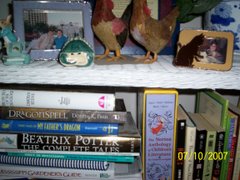I purposefully postponed Poetry Friday until today in order to celebrate Groundhog’s Day!
The earliest reference to Groundhog’s Day in American was made by a storekeeper in his diary on February 4, 1841 referring to February 2nd as Candlemas Day which to the Germans’ is Groundhog’s Day. Candlemas Day was celebrated by early Christians as the day Jesus was presented in the Temple, traditionally 40 days after Christmas. It is also a cross quarter day, the midpoint between the winter solstice and the spring equinox, and may be considered the beginning of Spring. In western Europe is was a time for preparing earth for first plantings. Since many hibernating animals such as bears and in Europe hedgehogs were thought to peek out of their dens to see if it was time to wake up, it is perhaps natural that this day became known as Groundhog’s Day by early settlers of North America. There were no hedgehogs there; but there were the chubby, furry rodents called groundhogs.
Margaret Hillert’s
“Is It True?”
The groundhog plays a little gameRobert Herrick’s
(Woodchuck is his other name.)
If he finds no shadow here,
Spring is very, very near.
But if he sees his shadow small,
Winter isn't done at all,
And back into his hole he'll creep
For six more weeks of winter sleep.
“The Ceremonies for Candlemas Day”
Kindle the Christmas brand, and thenPennsylvania’s Punxsutawney Phil saw his shadow this morning. But Georgia’s General Beauregard Lee did not. General Lee’s predictions over the years have proven to be 93% to 37% more accurate that Phil’s.
Till sunset let it burn;
Which quench'd, them lay it up again,
Till Christmas next return.
Part must be kept, wherewith to teend
the Christmas log next year;
And when 'tis safely kept, the fiend
can do no mischief there.
In my book . . . Though I enjoyed the surprise snow day here in south Mississippi, I think that I will choose to believe the General’s point of view.


